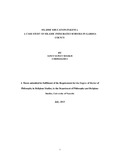Islamic Education in Kenya a Case Study of Islamic Integrated Schools in Garissa County
Abstract
This thesis explores the challenges facing Islamic education in Kenya with specific reference to Islamic Integrated schools that combines the national secular public school curriculum and Islamic education curriculum as taught in Madrasas and Qur‘anic schools. Throughout history, Islamic education has continued to adapt to the different environments and Islamic Integrated schools are not an exception. As indicated by the study, despite the many challenges, the schools have continued to provide a wholesome education, and in some areas by-passed the secular public schools in both enrolment attainment. The study has utilized the phenomenological approach to capture and describe the essence of Islamic Integrated Schools as a social phenomenon and the challenges they face in providing two different types of knowledge with different values. This study on the challenges facing Islamic Education in Kenya had four objectives: a) to identify the rationale for the establishment of Islamic integrated schools in Kenya b) to examine the curriculum of Islamic Integrated schools in terms of the number of subjects taught and the amount of content to determine curriculum overload c) to investigate the role of Islamic Integrated Schools in the education of Muslim children d) to explore the challenges facing Islamic Integrated schools. Field data from Garissa County was used to confirm the findings of the study. While the traditional Madrasa‟s are still growing, there are more students attending secular education with Madrasa‟s and Qur‘anic schools, attended in the afternoons, evenings and during weekends. The Madrasa‟s are autonomous institutions outside the control of the education authorities and were not therefore supervised as to the quality of education provided. Concerns have been raised about the amount of time children spend in the Islamic Integrated schools but the schools were found to cover two broad curricula which obviously calls for more time.
Finally, the study has identified the urban and ethnic bias of the Islamic Integrated schools phenomenon. The founders and more than 80 percent of the learners were found to be of the Somali ethnic group. This is an area that requires further study as
it would be of interest to Sociologists and Anthropologists. There will also be need to study the implication of teaching two foreign languages and a national language to pre-school and lower primary school children. The study also has implications for further research for planning and policy making in the field of education.
Citation
Degree of Doctor of Philosophy in Religious Studies, in the Department of Philosophy and Religious Studies, University of Nairobi. July, 2013Publisher
University of Nairobi, Department of Philosophy and Religious

